
SOL
Solana
| تریدر | نوع سیگنال | حد سود/ضرر | زمان انتشار | مشاهده پیام |
|---|---|---|---|---|
 mrsignalllSıralama: 86 | خرید | حد سود: تعیین نشده حد ضرر: تعیین نشده | 17 saat önce | |
 melikatrader94Sıralama: 189 | خرید | حد سود: تعیین نشده حد ضرر: تعیین نشده | 04.12.2025 | |
 DeGRAMSıralama: 101 | خرید | حد سود: تعیین نشده حد ضرر: تعیین نشده | 03.12.2025 | |
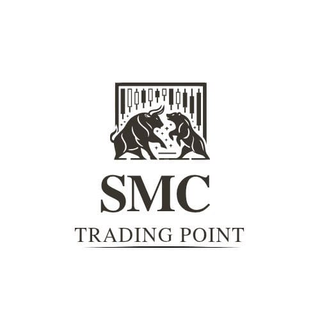 SMC_Trading_PointSıralama: 869 | فروش | حد سود: تعیین نشده حد ضرر: تعیین نشده | 2 saat önce | |
FxProSıralama: 789 | فروش | حد سود: تعیین نشده حد ضرر: تعیین نشده | 15 saat önce |
Solana Fiyat Grafiği
سود Üç Ay :
خلاصه سیگنالهای Solana
سیگنالهای Solana
filtre
Mesajı şuna göre sırala
Tüccar Türü
timeframe

SMC_Trading_Point
سولانا در خطر سقوط؟ هدف بعدی قیمت کجاست؟ (تحلیل ساختار بازار)
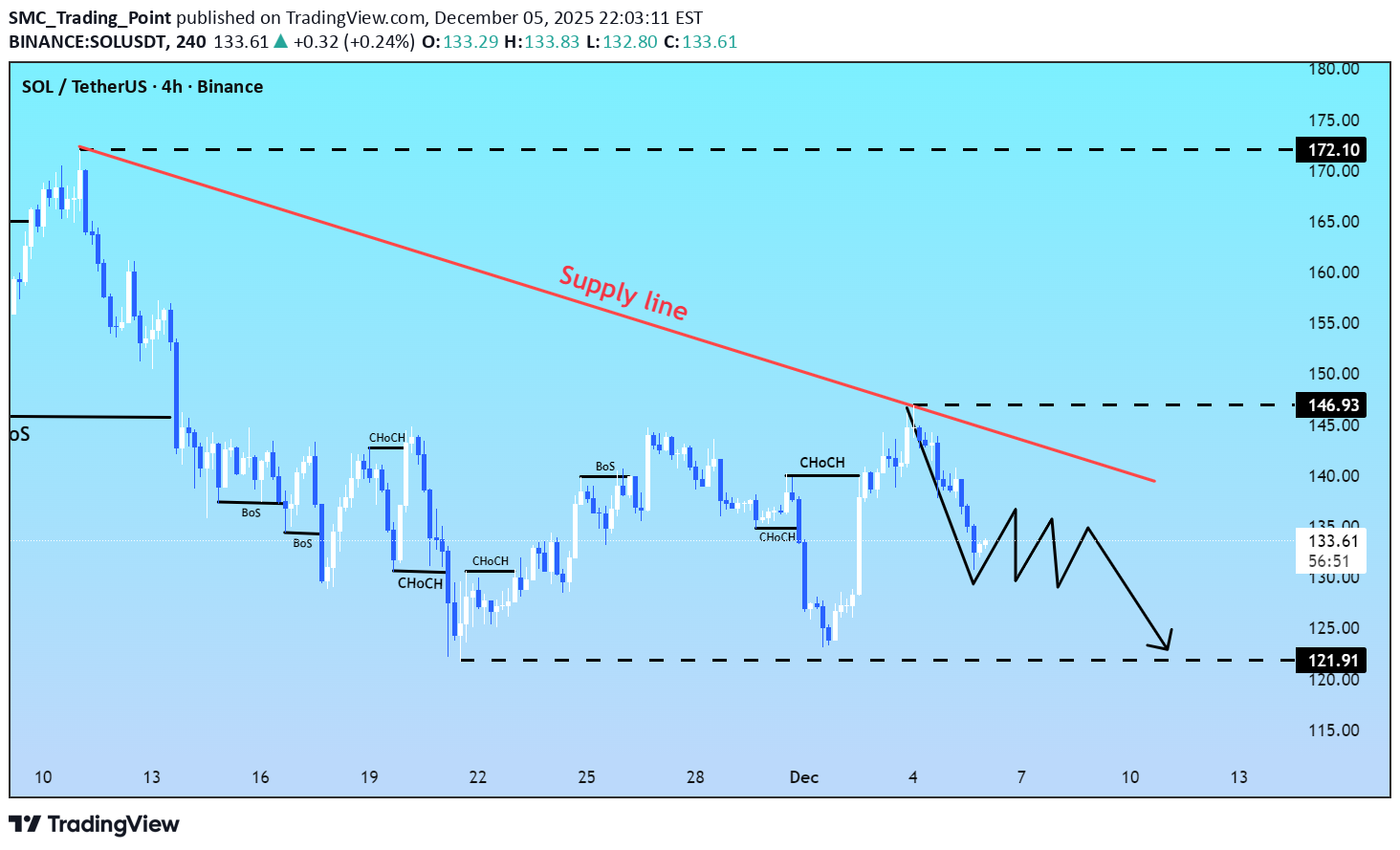
SOLUSDT 133,40 civarında işlem görüyor ve net bir arz hattının altında kalıyor, bu da satıcıların kısa vadede flow hakimiyetini sürdürdüğünü gösteriyor. Fiyat yakın zamanda tedarik bölgesinden tepki göstererek, azaltılmamış satış emirlerinin aktif olduğunu doğruladı. SMC açısından yapı, piyasayı düşüş yönlü sipariş akışı aşamasında tutarak daha düşük bir zirve gösteriyor. Kripto piyasaları genellikle move likidite döngülerindedir ve yukarı yönlü likidite zaten alınmıştır. Son yükseliş sırasında yeni talep yaratılmadığından fiyat, daha yüksek seviyeleri sürdürebilecek destekten yoksun. major çiftine ilişkin fonlama ve duyarlılık son zamanlarda nötrden düşüşe yönelerek yükseliş momentumunu azalttı. Piyasa likidite avlama eğiliminde ve 121,91 bölgesi, alıcı tarafının açık bir likidite havuzuna sahip. Bu bölge aynı zamanda birikimin daha önce gerçekleştiği bir önceki talep alanıyla da örtüşüyor. SOL arz hattının altında kaldığı sürece yukarıdaki dengesizlik fiyatı aşağı yönlü baskılamaya devam ediyor. Bu döküm, kripto fiyat yapısının eğitimsel olarak anlaşılması ve yalnızca öğrenme amaçlıdır. Fiyat arz hattının altında kaldığı sürece düşüş baskısı devam eder. Bu yapı bozulmadan fiyat, daha düşük likidite ve destek bölgesine doğru ilerlemeye devam edebilir. (Eğitici)
سولانا (SOL): هجوم نهنگها در منطقه حمایتی 130 دلاری؛ فرصت خرید طلایی یا دام بازار؟
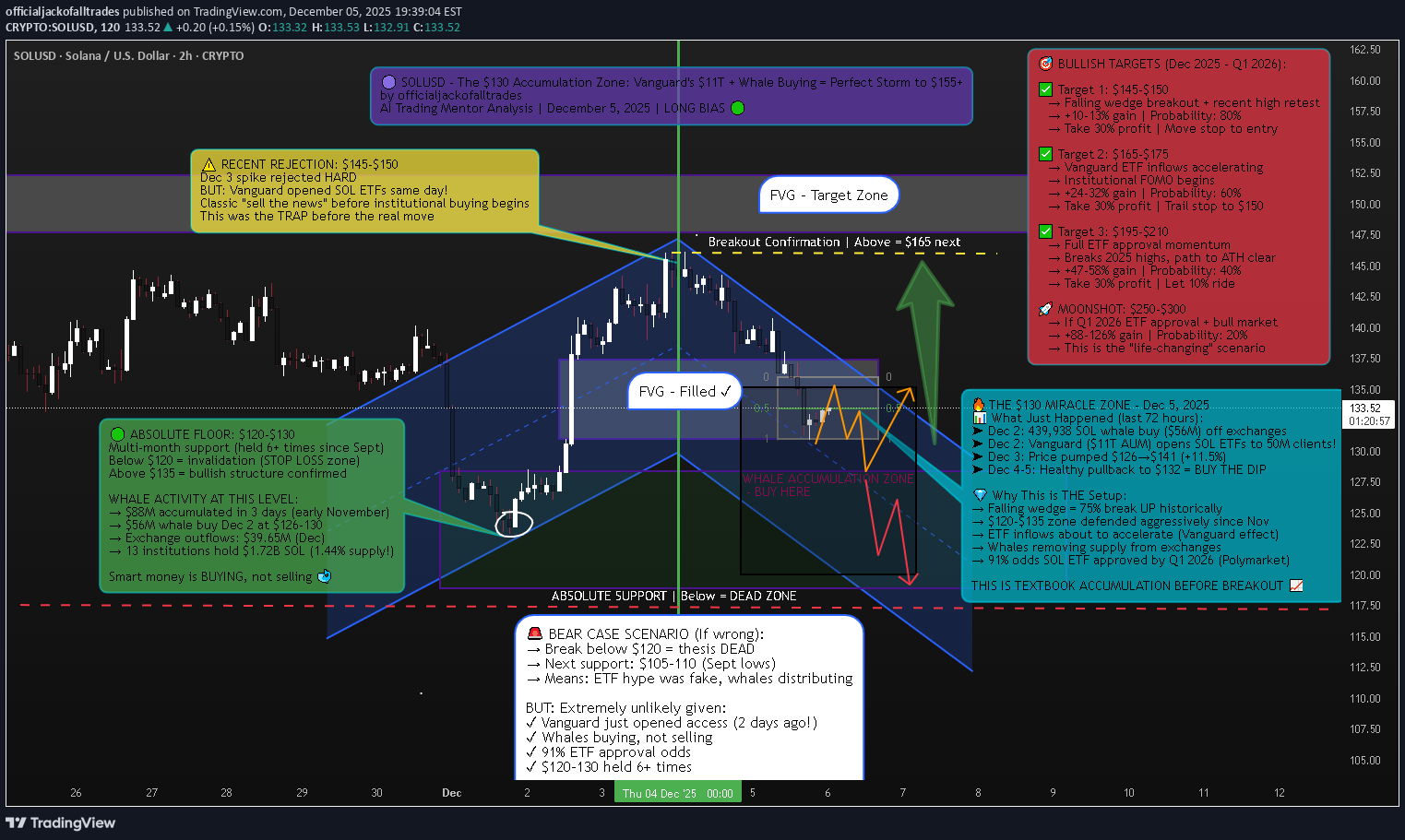
Jack Of All Trades SOL Analysis with AI Trading Mentor + AI Whale Bot Analysis 📈 The Setup - What My AI Trading Mentor & Whale Bot Just Found Current Price: $132.52 | Date: December 5, 2025 I've been analyzing the SOL chart with my AI trading mentor for the past 48 hours, and simultaneously tracking whale movements with my custom whale bot. What we discovered is absolutely insane. While retail traders are panic-selling this -4.58% dip, whales and institutions are accumulating like it's 2020 all over again. And they know something the market doesn't. Let me show you what's REALLY happening behind the scenes. 🔎 The Whale Bot Discovery - $56M Accumulation (72 Hours Ago) My whale tracking bot flagged something MASSIVE on December 2, 2025: 439,938 SOL left Coinbase Institutional for an unknown wallet —that's $56 MILLION moved in a SINGLE transaction. This wasn't panic selling. This was strategic accumulation. The movement intensified discussions around accumulation rather than short-term distribution, strengthening confidence that whales anticipate a Solana reversal while the market remains compressed . But here's where it gets REALLY interesting... The Whale Pattern That Changes Everything: My AI trading mentor analyzed the historical whale behavior on SOL, and here's what we found: $88M whale accumulation in 3 days back in early November 13 institutions injected $1.72B into Solana treasuries (1.44% of total supply!) $39.65M negative netflow (coins LEAVING exchanges) Translation? Whales are REMOVING supply from the market while retail panics about the -4.58% dip. Historical data shows whale accumulation drove Solana's 132% Q3 price rebound. We're seeing THE EXACT SAME PATTERN right now at $130. 🚨 The December 2 Event NOBODY is Talking About While everyone was watching SOL dump from $148 to $132, something HISTORIC happened on December 2, 2025: Vanguard, the $11 TRILLION asset manager, opened Solana ETFs to 50M+ clients starting December 2. Let me repeat that: $11 TRILLION. Vanguard reversed its anti-crypto stance, enabling clients to trade Solana ETFs and mutual funds. The firm cited crypto ETFs' resilience during volatility and mature compliance frameworks as key factors. Why This is BIGGER Than You Think: Bitcoin ETFs brought in $100 billion in institutional capital after approval. Sol ana is now getting the SAME treatment. Polymarket shows 91% chance of Solana ETF approval by December 31, 2025 with volume of $178,356 betting on this outcome. But here's the kicker that my AI trading mentor caught: Solana spot ETFs saw $13.55M net outflow on December 1, BUT Bitwise's BSOL ETF had $17.18M INFLOW. What does this mean? Retail is selling. Institutions are buying. Classic wealth transfer setup. 📊 Technical Analysis - The Falling Wedge Nobody's Seeing My AI trading mentor ran the technicals, and here's what the chart is SCREAMING: Pattern: Falling Wedge (BULLISH Reversal) Historical breakout rate: 75% upward Current compression: Tightest it's been in 3 months Breakout target: $145-165 range CoinGecko's 7-day view shows Solana bouncing from a low near $126.75 on Tuesday to about $141.65, with today's move alone adding roughly $14.64 in 24 hours . That bounce happened EXACTLY when? December 3 ONE DAY after Vanguard opened SOL ETFs. Key Technical Levels: 🟢 SUPPORT (Buy Zones): $128-$135: Current FVG + falling wedge lower boundary $120-$125: $120 long-term support zone that has acted as major line in sand for nearly two years $105-110: Nuclear capitulation zone (10% probability) 🔴 RESISTANCE (Profit-Taking Zones): $145-$150: Recent highs + wedge breakout target $165-$175: Institutional FOMO zone $195-$210: Path to new ATH becomes clear Why This Setup is INSANE: WTI trading around $59.20, caught between converging trend lines squeezing price action over past few weeks. Break above triangle resistance could trigger rally. Wait, that's oil. Let me correct that—SOL is showing the EXACT same compression pattern. SOL is still about 57% below its all-time high of $295.83 and is only recently rebounding from key $120 long-term support zone. Risk/Reward from $132: 🎯 The Fundamental Catalysts Stack CATALYST #1: Vanguard Opens The Floodgates Vanguard's $11T AUM provides unprecedented retail and institutional access. But here's what my AI trading mentor calculated: If just 0.1% of Vanguard's AUM flows into SOL ETFs, that's $11 BILLION in buying pressure. Current SOL market cap? $79 billion. That would be 14% of the entire market cap as NEW demand. What would that do to price? You do the math. CATALYST #2: Institutions Are Going ALL-IN 13 institutions injected $1.72B into Solana treasuries, leveraging 7-8% staking yields. But here's the part that blew my mind: Sharps Technology and Upexi Inc. lead this trend, allocating $445.4M and $260M, respectively. These aren't crypto-native firms. These are TRADITIONAL COMPANIES moving into SOL. FalconX and Wintermute purchased 44,000 SOL worth $8.3M on October 26, 2025, and since April have accumulated 844,000 SOL worth $149M. Pattern? Institutional accumulation is ACCELERATING, not slowing. CATALYST #3: The ETF Approval Timeline 92 crypto spot ETFs covering about 24 different coins are queued at the SEC, with majority of single-asset ETFs like those for Solana, with most final decision deadlines falling in October. Wait, October already passed. What happened? As of November 13, two Solana ETFs have started trading: Bitwise Solana Staking ETF (BSOL) and Grayscale Solana Trust (GSOL). SOL ETFs are ALREADY LIVE! JPMorgan expects Solana ETFs to see about $1.5B in first-year inflows. That's $1.5B of guaranteed buying pressure over the next 12 months. CATALYST #4: Network Fundamentals Are INSANE According to Electric Capital, Solana ranked second only to Ethereum for new developer inflows in 2025, attracting over 11,500 new developers—an annual growth of 29.1%. More developers = More dApps = More users = Higher demand for SOL. Solana stays fast and low-cost, with high throughput and low latency. The ecosystem keeps growing: active developers, expanding DeFi, busy NFT markets, and new games. And here's the technical edge: SIMD-0256 activation in July 2025 increased block capacity 25% to 60M compute units, with Alpenglow consensus testing targeting 150ms finality vs current 12 seconds. Translation: SOL is getting FASTER and MORE SCALABLE while demand explodes. 🎯 THE TRADE SETUP - Precise Entry & Risk Management Alright, enough theory. Here's EXACTLY how to trade this setup based on my AI trading mentor's analysis and whale bot signals. 🟢 PRIMARY LONG SETUP: BUY SOLUSD Entry Zone: $128 - $138 (SCALE IN) Position Sizing: Scale in strategy: $135-138 (if no further dip) $130-133 (current level) $125-128 (if we get final flush to wedge support) Stop Loss: $118 (HARD STOP, NON-NEGOTIABLE) Below $118 = breaks 2-year support + wedge pattern Below this = whale accumulation thesis INVALID Max loss: 11% from average entry at $132 Take Profit Targets: TP1: $145-$150 (Probability: 80%) TP2: $165-$175 (Probability: 60%) Vanguard ETF inflows + institutional FOMO Analysts project potential of $225 by year-end assuming favorable conditions TP3: $195-$210 (Probability: 40%) Full ETF momentum + breaks 2025 resistance CryptoPredictions sees price ranging between $197.29 and $290.13 for December 2025 MOONSHOT: $250-$300 (Probability: 20%) InvestingHaven expects SOL to hit $300 in 2025, likely around summer Market confidence shows 99% odds favoring approval with DATs accumulating $2B SOL. Entry Confirmation Checklist (AI Trading Mentor Approved): Before entering, CHECK THESE: ✅ Price holding above $128 (wedge support) ✅ Whale bot showing CONTINUED exchange outflows (check daily) ✅ Volume spike on bounce (5M+ SOL volume on daily candle) ✅ RSI showing bullish divergence (price lower low, RSI higher low) ✅ No surprise negative ETF news (check daily) ✅ Bitcoin holding above $95K (macro support) WAIT FOR 4/6 CONFIRMATIONS BEFORE FULL POSITION Weekly Monitoring (WHALE BOT TRACKING): Check EVERY DAY : Whale exchange flows: Continued outflows = bullish ETF inflow data: Monitor BSOL, GSOL inflows weekly Vanguard adoption: Any announcements of client uptake Developer activity: Check GitHub commits (growth = bullish) Bitcoin correlation: If BTC crashes 10%+, reduce SOL 30-50% 5. Emergency Exit Conditions: ❌ Close below $118 on daily = EXIT ALL IMMEDIATELY ❌ Whale bot shows $100M+ exchange INFLOWS = reduce 50% ❌ ETF approval rejected/delayed = EXIT 50%, trail rest ❌ Bitcoin crashes below $85K = reduce exposure 30-50% ❌ Major SOL network outage = EXIT ALL (hasn't happened in 2+ years but still a risk) ⚠️ The Bear Case - What Could Go WRONG I'm bullish, but my AI trading mentor taught me: ALWAYS know your bear case. Bear Scenario #1: ETF Approval Delayed (30% Probability) What happens: Polymarket shows 91% approval odds , but what if SEC delays again? Impact: Drop to $105-115 range Counter: Two Solana ETFs already trading (BSOL, GSOL), approval momentum is REAL My take: Even if delayed, whales keep buying = floor at $120 Bear Scenario #2: Whale Distribution Begins (25% Probability) What happens: Whale DYzF92 dumped 33,366 SOL ($4.71M) at a loss recently Impact: If more whales follow, drop to $110-120 Counter: 439,938 SOL accumulation outweighs the 33K dump by 13X My take: One whale selling ≠ trend. NET whale flow is BULLISH. Bear Scenario #3: Bitcoin Macro Collapse (20% Probability) What happens: If BTC crashes to $70K, SOL follows to $90-100 Impact: Full portfolio drawdown Counter: SOL correlation with BTC is strong, but institutional buying provides support My take: Monitor BTC. If breaks $90K, cut SOL exposure 50%. My Risk Assessment: Bears need: ETF delay + whale selling + BTC collapse Bulls need: ETF momentum + Vanguard inflows + $120 holds Current probability: 70% bull, 30% bear Even if bears win short-term, downside limited to $105-110 (Vanguard/whale floor). But upside? $195-250+ (institutional FOMO). 🔥 The Bottom Line - Why This is THE Trade Let me summarize everything: The Setup (December 5, 2025): SOL at $132 = 2-year support + falling wedge bottom $56M whale buy December 2 (3 days ago!) Vanguard opens SOL ETFs December 2 (2 days ago!) Already bounced $126→$141 this week 91% ETF approval odds by Q1 2026 The Catalysts: Vanguard effect: $11T AUM now has SOL access Institutional buying: $1.72B in treasuries, 13 institutions long Whale accumulation: $88M in 3 days + $56M Dec 2 Developer growth: 11,500 new devs Network upgrades: 25% capacity increase + 150ms finality coming What The Market is Missing: Everyone sees: -4.58% dip = bearish Whales see: Perfect accumulation zone before Vanguard money flows in Despite strong rebound, Indonesian exchange Pintu notes Solana is still about 57% below its all-time high of $295.83. That's not a bug. That's a FEATURE. We have 57% room to run back to ATH, and we're sitting at 2-year support with $11 TRILLION in new capital about to enter through Vanguard. 🎯 Action Plan - What To Do RIGHT NOW IF YOU'RE BULLISH (Recommended by AI Trading Mentor): Set Alerts: Alert at $128 (aggressive buy - wedge support test) Alert at $133 (current - scale in point) Alert at $138 (last entry before breakout) Alert at $145 (take profit trigger) IF YOU'RE BEARISH: Wait for: Close above $150 with volume (breakout confirmed) Then enter on $145-148 retest Safer but worse risk/reward IF YOU'RE NEUTRAL: Allocate 3-4% of portfolio (half position) Enter at $130-135 only Take profits at $155 (+19%) This is the "I believe but I'm cautious" play Final Thoughts - The Truth About This Setup My AI trading mentor has analyzed thousands of setups. Here's what I KNOW for certain on December 5, 2025: ✅ 439,938 SOL ($56M) removed from Coinbase Dec 2 ✅ Vanguard ($11T) opened SOL ETFs Dec 2 ✅ 13 institutions hold $1.72B SOL (1.44% supply) ✅ 91% ETF approval odds on Polymarket ✅ $120 support held for 2 years ✅ Falling wedge = 75% break upward historically ✅ $100B flowed into BTC after ETF approval Here's what I DON'T know: Will Vanguard inflows start immediately or take months? Will whales keep accumulating or start distributing? Will BTC hold or crash? Drop a 🟣 if you're buying SOL at $130-135. Drop a 🤖 if you're using AI to refine and help guide you with setups like this. Drop a 🐋 if you're following whale accumulation. Drop a 💰 if you're ready for $

EyeDoctor
تحلیل موج الیوت: راز سطوح فیبوناچی در نوسانات بازار
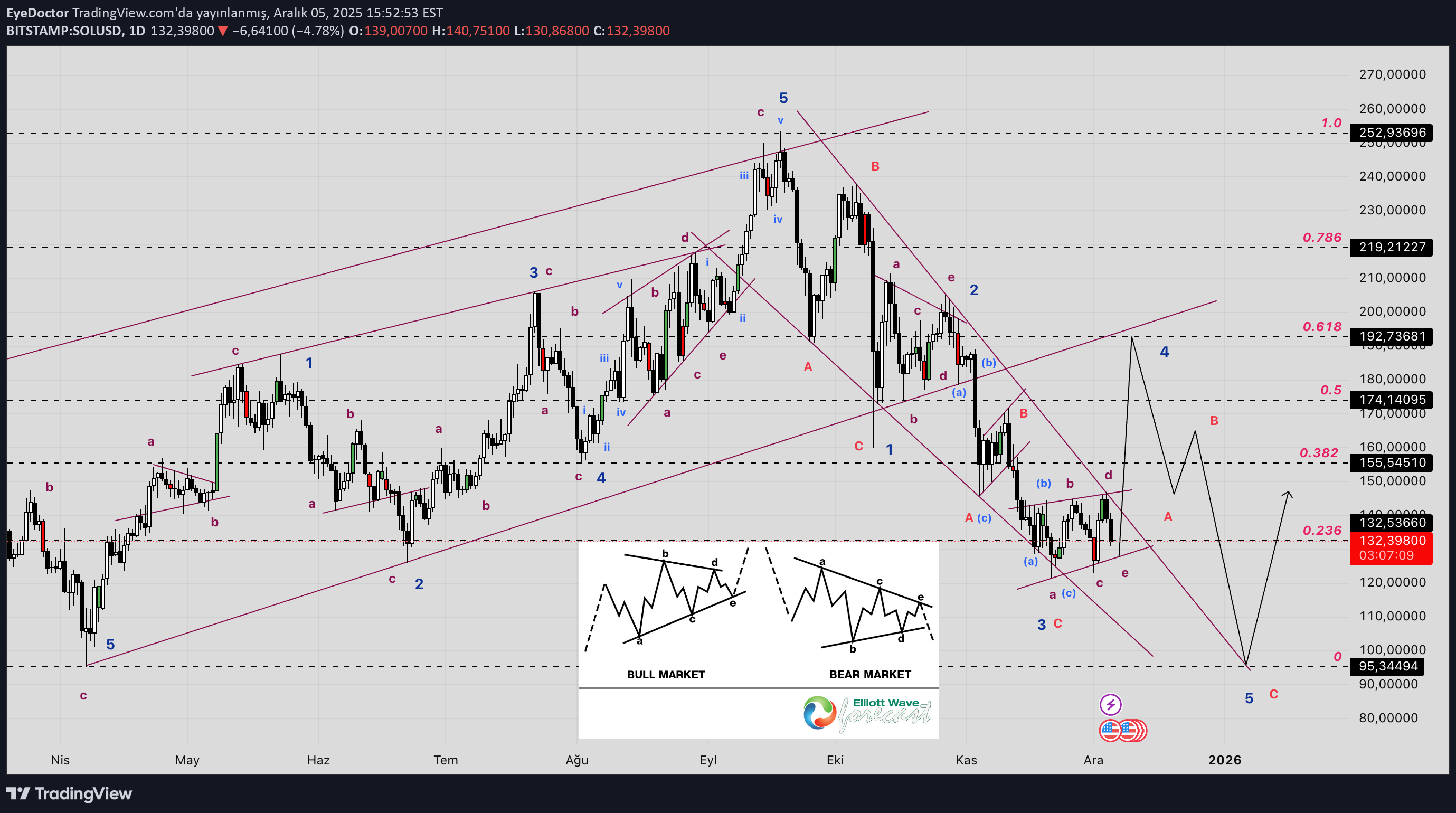
,,,,, ,,,,, Elliot Dalga Analizi Fibonacci Seviyeleri ,,,,, ,,,,,
FxPro
تحلیل موجی سولانا (SOL): ریزش به سمت حمایت ۱۳۰ دلار قطعی شد؟
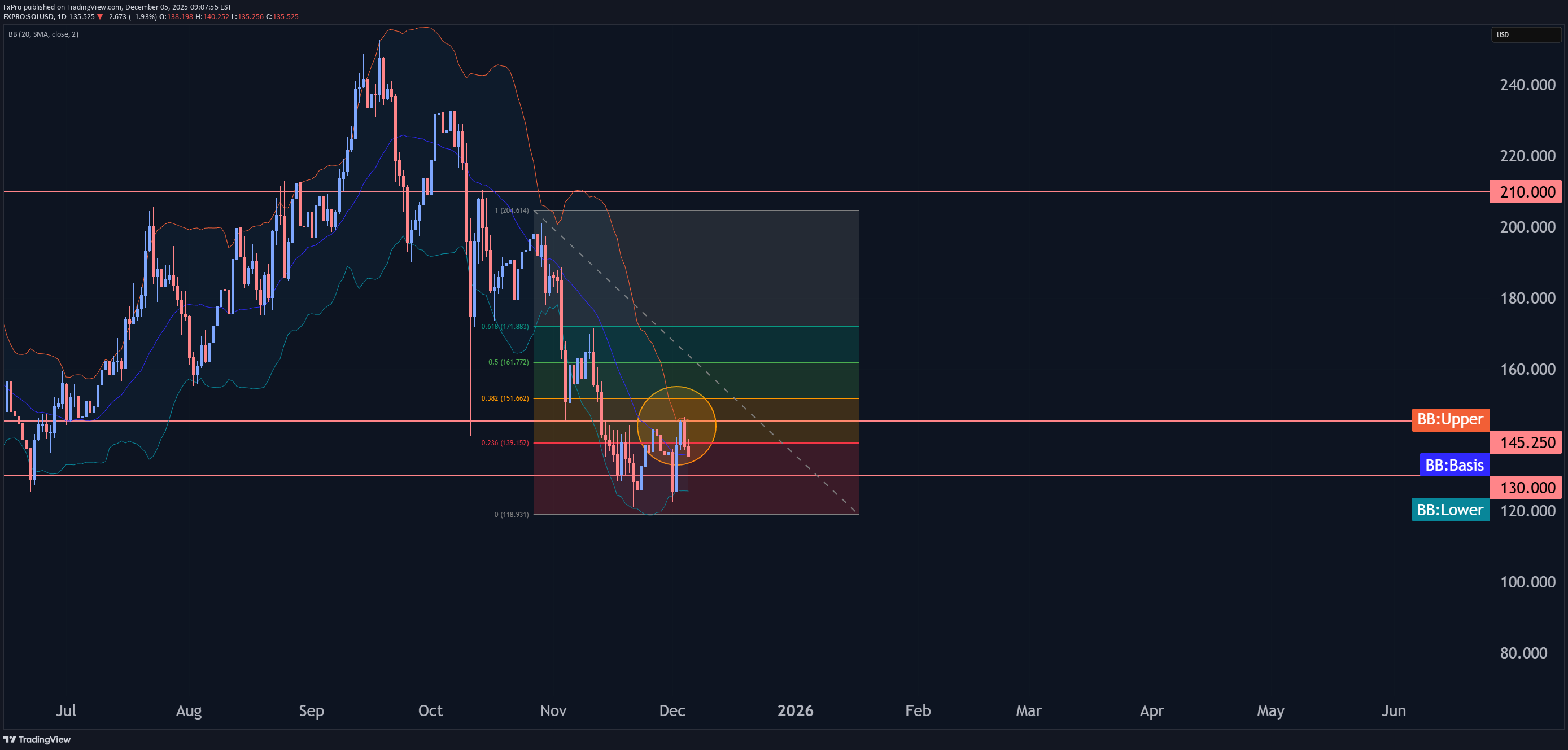
- Solana direnç bölgesinden ters çevrildi - 130.00 destek seviyesine düşmesi muhtemel Solana kripto para çifti yakın zamanda 145,25 direnç seviyesi (Ekim ve Kasım aylarındaki eski güçlü destek) ile günün üst seviyesi Bollinger Band arasındaki direnç bölgesinden geri döndü. Bu direnç bölgesi, Kasım ayındaki aşağı yönlü ivmenin %50 Fibonacci düzeltmesiyle güçlendirildi. Solana kripto para biriminin bir sonraki destek seviyesi olan 130,00'a düşmesi beklenebilir (bu seviye Haziran ayından bu yana fiyatı istikrarlı bir şekilde tersine çeviriyor).
تحلیل تکنیکال سولانا (SOL/USD): حرکت بعدی قیمت کجاست؟
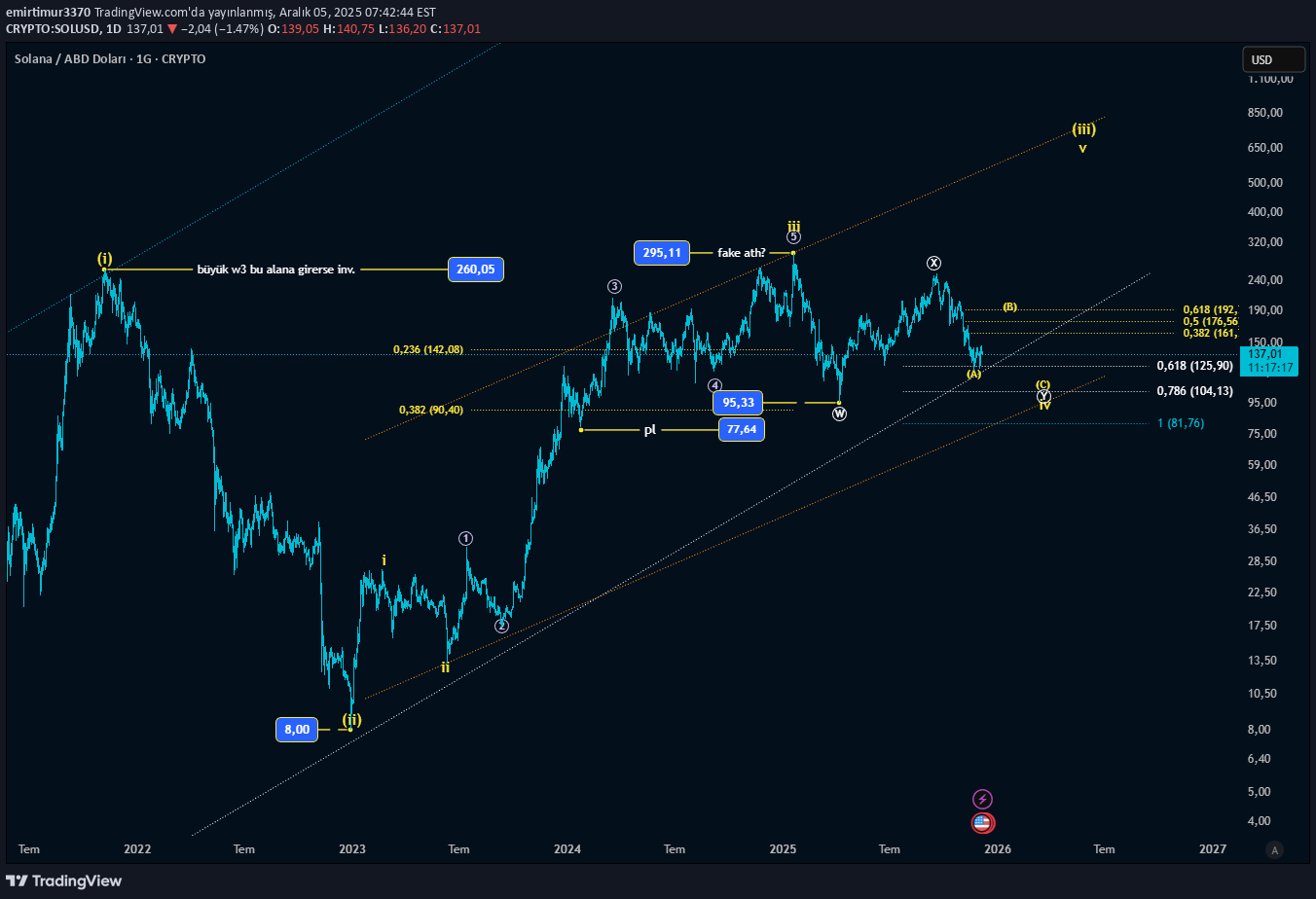
Elliott olarak böyle bir projeksiyonum var. Bir yukarı bir aşağı sonrası tekrar w3'ün w5'ini yaparız gibi. En kötü muhtemel Turuncu 1-2-4 Kennedy kanalı alt çizgiden sekmemiz lazım. Protected Low(PL) korundukça pozitifliğimizi korumakta fayda var. YTD.

mrsignalll
تحلیل تکنیکال سولانا (SOL/USDT): فرصت خرید در تایم فریم یک ساعته پس از شکست مقاومت!
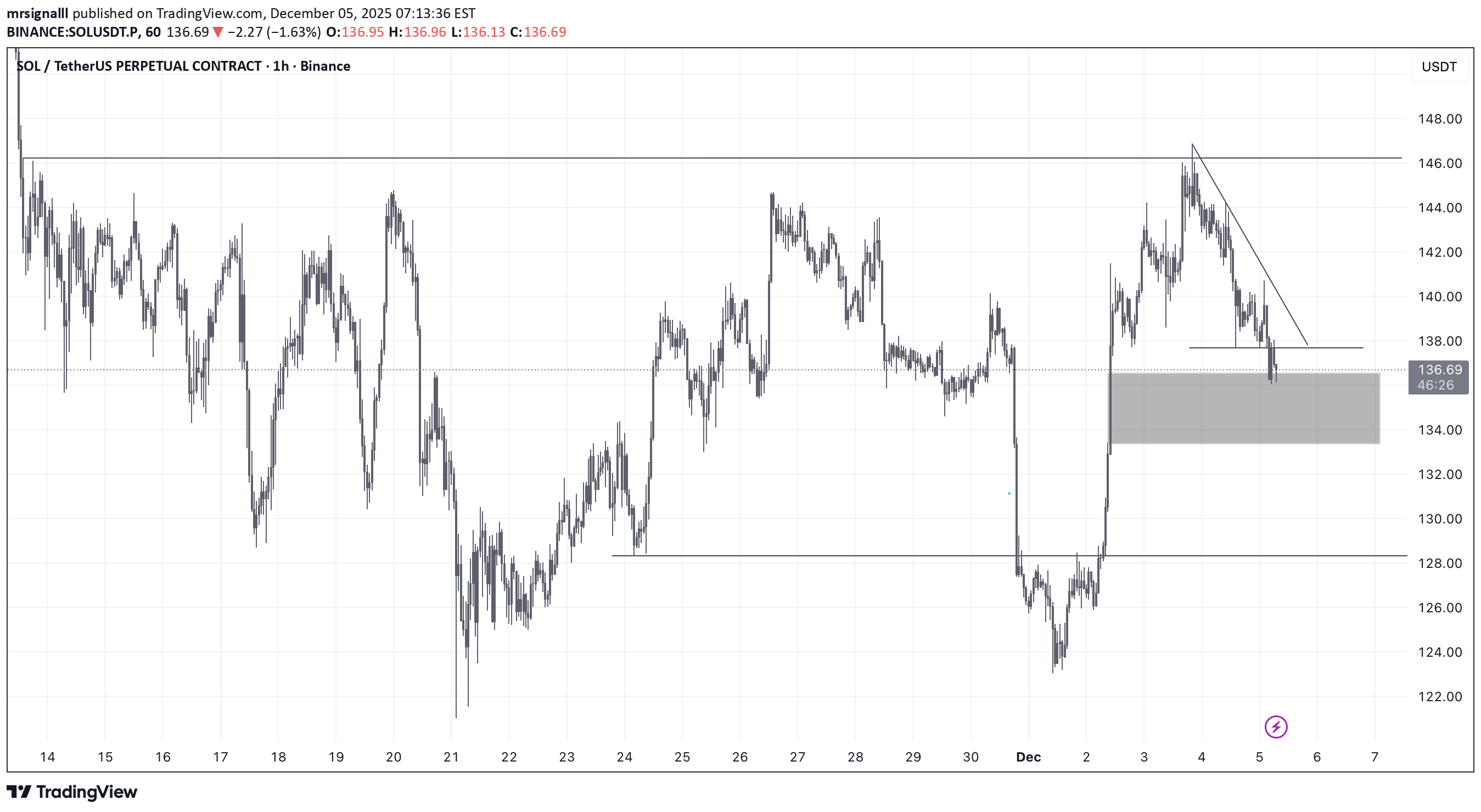
#SOLUSDT | 1 SAATLİK ZAMAN ÇİZELGESİ GÜNCELLEMESİ 1 saatlik zaman diliminde #SOL'a bakarsanız, fiyatın son 21 günde geniş bir aralıkta hareket ettiğini görebilirsiniz. Bu aralıkta #Solana şu anda düşüş eğiliminde. Uzun bir pozisyon için ideal senaryo, fiyatın trend çizgisinin üzerine çıkmasıdır ve temiz bir geri çekilme/onaylamanın ardından satın alma girişlerini aramaya başlayabiliriz.

Smarttrader0786
تحلیل کامل: استراتژی ترید SMC برای فروش در جفت ارز SOLUSDT (سطوح کلیدی قیمت)
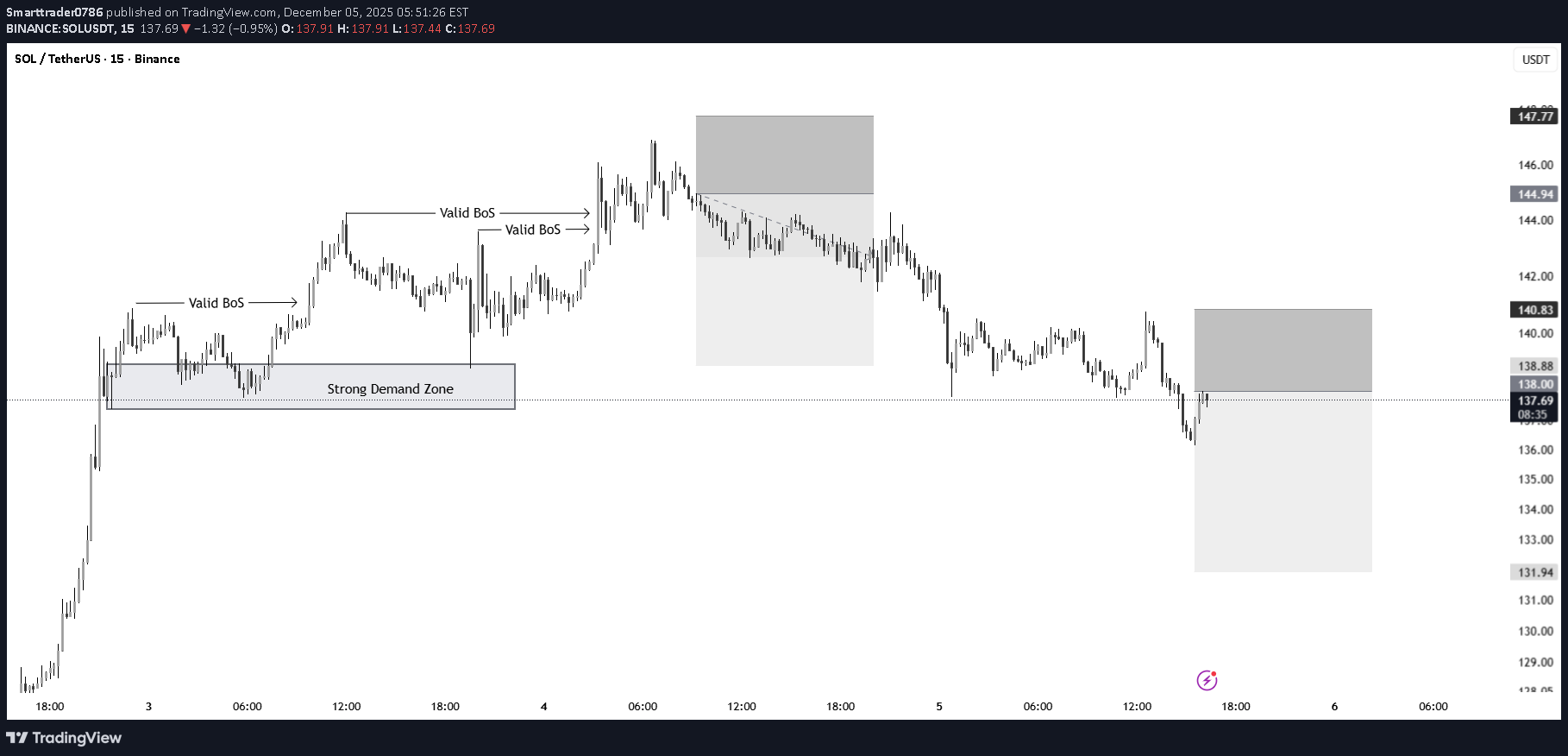
Bu Analizde paylaştığım bazı Alış veya Satış Seviyelerini görebilir, dikkatlice izleyebilir ve Fiyat Takip aksiyonunu görebiliriz. Teşekkür etmek
tomas_jntx
سولانا زیر مقاومت گیر افتاده: آیا سقوط ادامه دارد؟
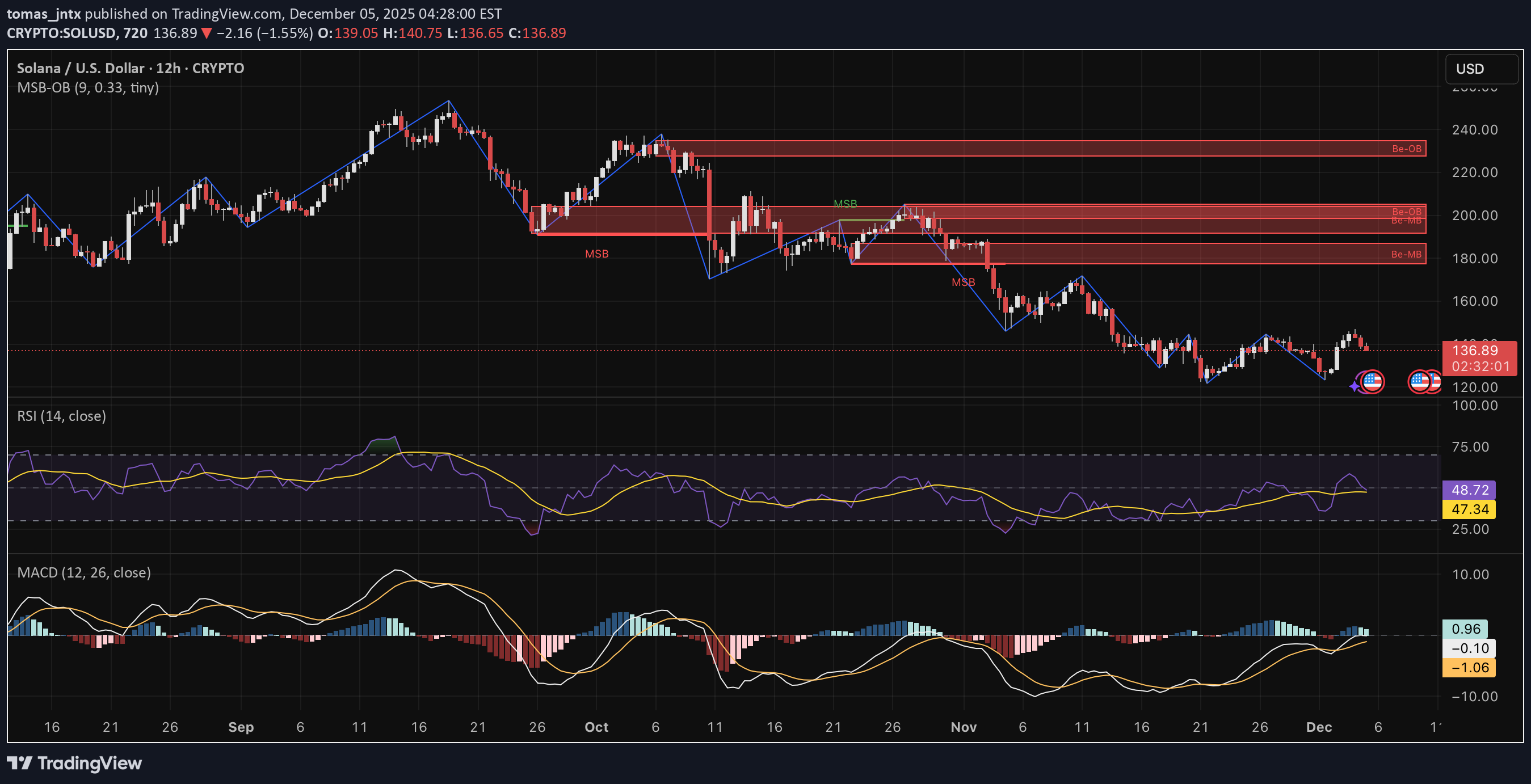
SOL hala 160-180 OB bölgesinin altında işlem görüyor ve görünürde yükselişe yönelik bir piyasa yapısı kırılması yok. RSI 50 civarında seyrediyor ve MACD karışık kalmayı sürdürüyor. SOL 145-150'nin altında kaldığı sürece eğilim potansiyel kesintiyle birlikte aşağı yönlü olmaya devam ediyor. Bu eğilimi kararlı bir şekilde değiştirmek için alıcıların 160'ı kırması gerekiyor. Önyargı: Ayı Çift: SOL/USDT Zaman aralığı: 12 saat Bu finansal tavsiye değil, yalnızca data analizidir. Kişiselleştirilmiş rehberlik için lütfen nitelikli bir finans uzmanına danışın.
سولانا (SOL): توقف صعود بزرگ و منطقه سرنوشتساز پیش رو!
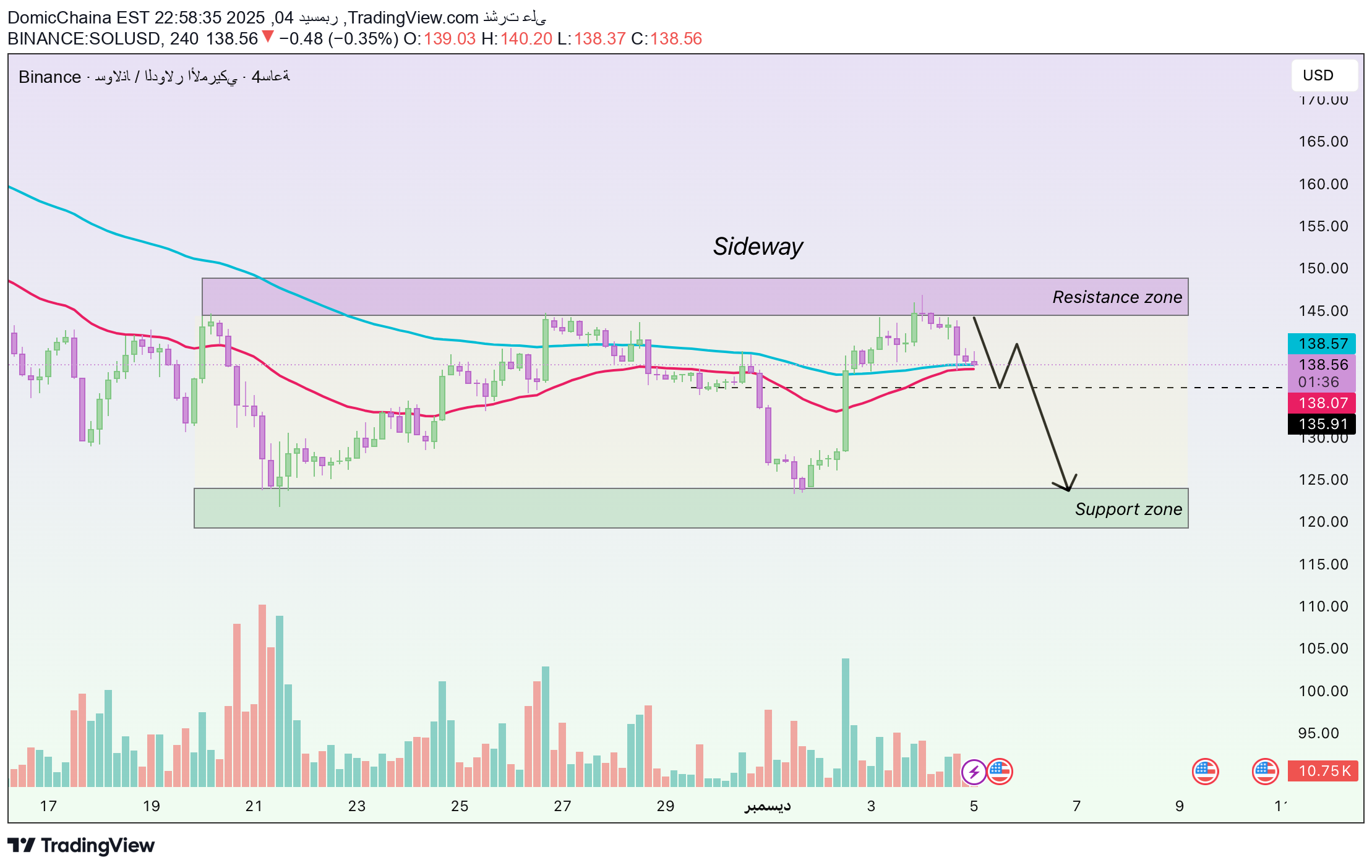
SOL hafta sonu kayda değer bir yükseliş gördü, ancak fiyat, geçen ay daha önce güçlü satış baskısı gören bir alan olan EMA 89'a (mavi) ulaştığında mevcut ivme açıkça zayıfladı. SOL, 145$ seviyesi civarında yükseldikten sonra EMA 34 (kırmızı) ve EMA 89'u test etmek için geri döndü ve bir sonraki trendi belirlemek için önemli bir yakınsama bölgesi oluşturdu. Son mumlar uzun üst gölgeler ve düşük işlem hacmi gösteriyor; bu da önceki kırılmaya kıyasla alıcıların zayıf olduğunu ve kar alma baskılarının arttığını gösteriyor. Piyasa yapısı hâlâ yükseliş trendini doğrulamıyor: SOL net bir yüksek-yüksek oluşturmadan yerel yüksekleri yalnızca hafif kırdı, bu da EMA 89'daki reddi açıklıyor. Makroekonomik ve likidite akışı açısından bakıldığında, سولانا ekosistemi son 48 saatte olumlu bir toparlanma kaydetti; bazı DeFi projeleri ve memcoin yükselişe geçti. Ancak yatırımcılar ABD Merkez Bankası'ndan ve ABD ekonomik verilerinden gelecek sinyalleri beklerken altcoinlere sermaye akışı durdu. Bitcoin şu anda yatay bir trend izliyor, bu da piyasanın SOL de dahil olmak üzere altcoinlere yönelik temel baskısının yeni bir çıkış yaratmak için yetersiz olduğu anlamına geliyor. Şu anda olumlu haberler bile yeni bir trend oluşturmaya yetmiyor.
سولانا (SOL) در دوراهی حساس: خریداران کم آوردند؟ آینده قیمت چه میشود؟
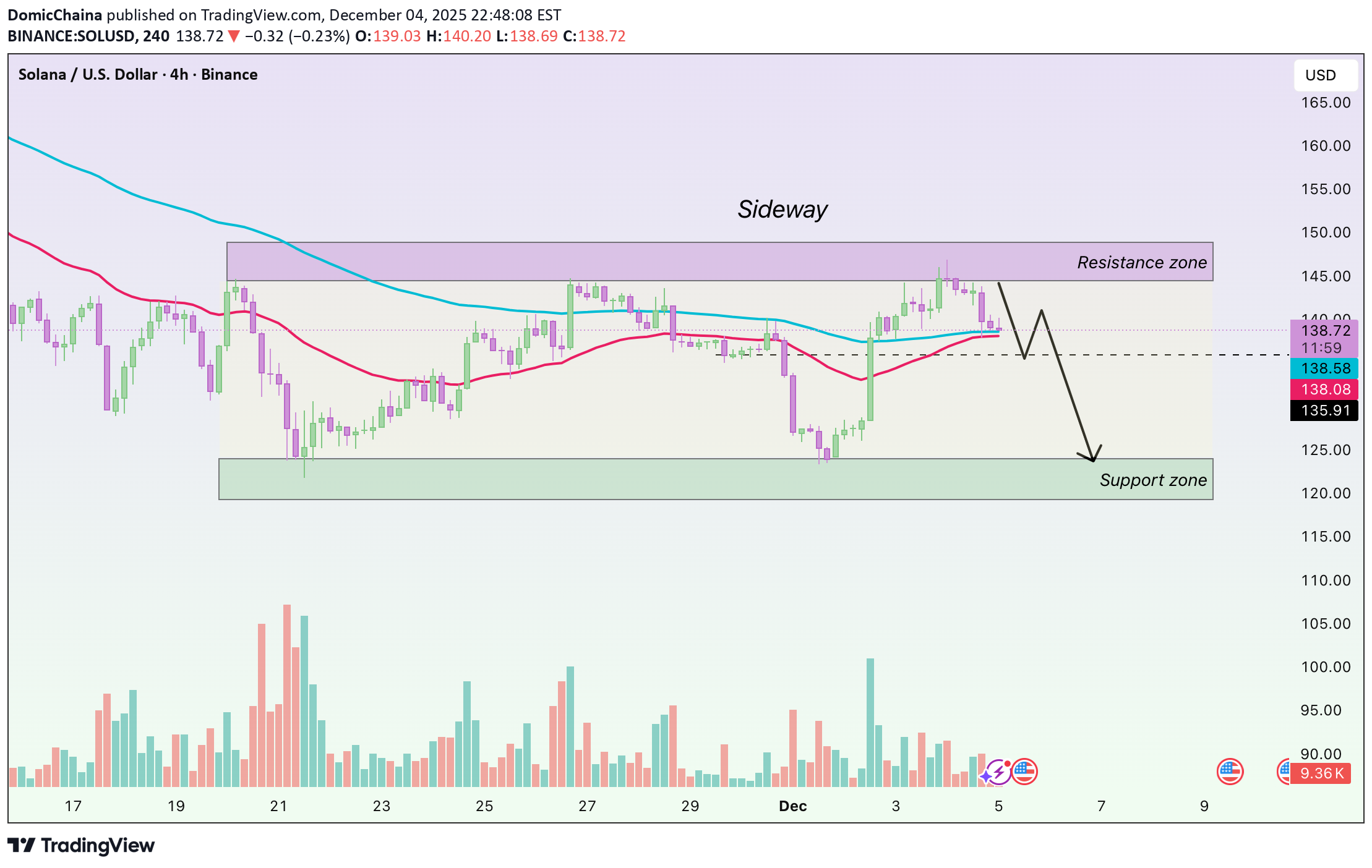
Herkese merhaba, SOL geçtiğimiz hafta sonu etkileyici bir yükseliş move yaşadı, ancak fiyatın geçen ay daha önce güçlü bir satış baskısı yaratan bir alan olan EMA 89'a (mavi) ulaşmasıyla mevcut momentum gözle görülür biçimde zayıfladı. SOL, 145 ABD doları civarında sıçradıktan sonra hem EMA 34 (red) hem de EMA 89'u test etmek için geri çekildi ve bir sonraki yönü belirlemek için kritik bir yakınsama bölgesi oluşturdu. Son dönemdeki mumlar, azalan hacmin eşlik ettiği uzun üst fitilleri gösteriyor; bu da alıcıların kar alma baskısı artarken önceki kırılmaya kıyasla güç kaybettiğini gösteriyor. Piyasa yapısı henüz bir yükseliş trendini onaylamadı, çünkü SOL net bir yüksek-yüksek oluşturmadan yerel yüksekleri yalnızca hafifçe kırdı, bu da fiyatın EMA 89'da neden reddedildiğini açıklıyor. Makro ve sermaye flow perspektifinden bakıldığında, son 48 saat içinde Solana ekosistemi, birçok DeFi projesi ve memecoin'in yükselişiyle olumlu bir iyileşme gösterdi. Ancak yatırımcılar Fed ve ABD ekonomisinden gelecek güncellemeleri beklerken altcoinlere sermaye akışı durakladı data. Bitcoin şu anda yana doğru hareket ediyor, bu da SOL dahil altcoinleri destekleyen birincil piyasa momentumunun bir çıkış sağlamak için yetersiz olduğu anlamına geliyor. Dolayısıyla olumlu haberler bile henüz yeni bir trend oluşturacak kadar güçlü değil. Herkese başarılı ticaretler diliyorum!
Sorumluluk Reddi
Sahmeto'nun web sitesinde ve resmi iletişim kanallarında yer alan herhangi bir içerik ve materyal, kişisel görüşlerin ve analizlerin bir derlemesidir ve bağlayıcı değildir. Borsa ve kripto para piyasasına alım, satım, giriş veya çıkış için herhangi bir tavsiye oluşturmazlar. Ayrıca, web sitesinde ve kanallarda yer alan tüm haberler ve analizler, yalnızca resmi ve gayri resmi yerli ve yabancı kaynaklardan yeniden yayınlanan bilgilerdir ve söz konusu içeriğin kullanıcılarının materyallerin orijinalliğini ve doğruluğunu takip etmekten ve sağlamaktan sorumlu olduğu açıktır. Bu nedenle, sorumluluk reddedilirken, sermaye piyasası ve kripto para piyasasındaki herhangi bir karar verme, eylem ve olası kar ve zarar sorumluluğunun yatırımcıya ait olduğu beyan edilir.

